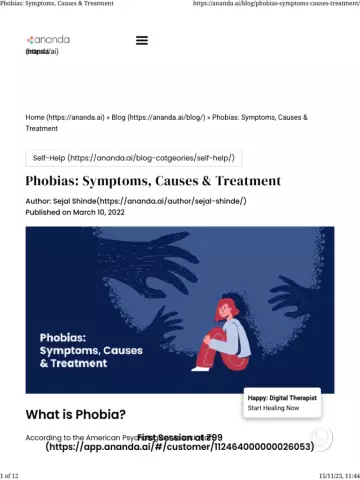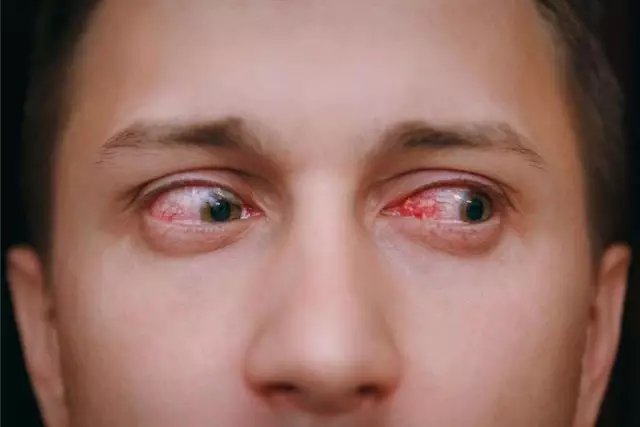- Author Rachel Wainwright [email protected].
- Public 2023-12-15 07:39.
- Last modified 2025-11-02 20:14.
Phenylketonuria
Brief description of the disease

Phenylketonuria is a hereditary disease characterized by impaired protein metabolism.
This disease was first discovered in 1934. Phenylketonuria is inherited in a so-called autosomal recessive manner, that is, children with phenylketonuria can be born to perfectly healthy parents (carriers).
Types of phenylketonuria
There are 3 types of this disease.
Phenylketonuria of the first type is characterized by a deficiency in the body of the enzyme phenylalanine-4-hydroxylases. Thanks to this enzyme, the amino acid phenylalanine is converted to tyrosine. This type of phenylketonuria is most often inherited (in 98% of cases).
Phenylketonuria of the second type is characterized by a lack of such an enzyme as dihydropteridine reductase. Patients with type II phenylketonuria suffer from seizures and mental retardation. This type of phenylketonuria in children is quite rare (1-2%), but usually leads to death at the age of 2-3 years.
Phenylketonuria of the third type is characterized by a deficiency of tetrahydrobiopterin. Symptoms of this type of phenylketonuria include mental retardation due to microcephaly - a decrease in brain volume.
Phenylketonuria causes
The main reasons for the development of phenylketonuria in children are considered to be mutations in a gene located on chromosome 12. Family marriages increase the risk of anomalies.
With a deficiency of certain enzymes, an increase in the blood of phenylalanine derivatives is observed, which have a toxic effect on the child's nervous system. Phenylketonuria is inherited in about the same way by both boys and girls.
Phenylketonuria symptoms
Symptoms of phenylketonuria do not appear immediately. In most cases, it is almost impossible to suspect phenylketonuria in babies immediately after birth. The child looks healthy, is born on time and with normal weight. But after a few weeks, symptoms of phenylketonuria appear. The main symptom of the disease is severe vomiting. In the period from two to six months, both the mother and the attending doctor may notice a lag in the child's mental and physical development.
Children with phenylketonuria begin to sit and walk later than other peers. Also, a clear symptom of phenylketonuria is increased sweating with a characteristic "mouse" smell of sweat. There are convulsions, irritability, lethargy, moodiness and tearfulness, a decrease in the size of the head, and skin rashes. In children with phenylketonuria, teeth erupt late.
With the development of phenylketonuria, muscle tone increases, which is characterized by a certain pose in the child, which is also called the "tailor's pose" (arms and legs bent at the joints).
Phenylketonuria treatment

The only cure for phenylketonuria is diet, which must be followed for more than ten years after diagnosis. Children with phenylketonuria cannot absorb large amounts of phenylalanine, so there are certain norms for its intake, which depend on age. A child under two months old can consume no more than 60 mg / kg of phenylalanine weight, and children over six years old - no more than 10-15 mg / kg.
When it comes to breastfeeding, there are strict rules to follow. The mother must control the amount of breast milk that the baby drinks. Therefore, for feeding, it is necessary to use only expressed milk and in an amount that is allowed for a certain age of the child. For this, there are special tables with the rates of phenylalanine consumption, as well as formulas for calculating the amount of breast milk per day. The child is fed with special mixtures that do not contain phenylalanine.
The introduction of complementary foods in children with phenylketonuria begins with fruit and berry juices. As a solid food, the child is offered vegetable purees without milk added. Protein-free cereals and dairy-free cereals based on rice or corn flour are used.
Treatment of phenylketonuria through nutrition includes avoiding or very limited consumption of foods such as fish, meat, baked goods, sausages, cottage cheese, eggs, chocolate, legumes, nuts and cereals. These foods are high in protein. Fruits and vegetables are introduced into the diet taking into account the calculation of the amount of phenylalanine in them.
Drug treatment for phenylketonuria involves taking vitamins, calcium, iron and phosphorus preparations. Also shown is the intake of drugs to improve cerebral circulation, microcirculation and tissue metabolism. Physical therapy and massage are recommended.
YouTube video related to the article:
The information is generalized and provided for informational purposes only. At the first sign of illness, see your doctor. Self-medication is hazardous to health!






